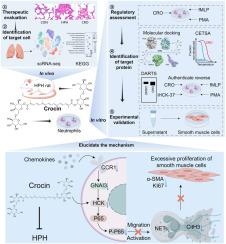Crocin inhibits neutrophil migration and activation to treat hypoxic pulmonary hypertension through targeting HCK
IF 8.3
1区 医学
Q1 CHEMISTRY, MEDICINAL
引用次数: 0
Abstract
Background
Crocin (CRO) holds promise as a treatment for hypoxic pulmonary hypertension (HPH); however, its pharmacological mechanism remains poorly understood.
Objectives
We investigated how CRO improves HPH by acting on multiple cell types and pathological pathways, using single-cell RNA sequencing (scRNA-seq).
Materials and methods
We first established a hypoxia-induced HPH rat model to evaluate the therapeutic effects of CRO. We then performed scRNA-seq to analyze how CRO alters cell populations and gene expression. Then, the effects of CRO on neutrophil migration and activation were investigated. Furthermore, molecular docking, cellular thermal shift assay (CETSA), and drug affinity responsive target stability (DARTS) were used to validate the direct target of CRO. Finally, a co-culture system of neutrophils and pulmonary arterial smooth muscle cells (PASMCs) was used to confirm the link between CRO-mediated inhibition of PASMCs proliferation and neutrophil migration and activation.
Results
In HPH rat model, CRO treatment significantly improved hemodynamic parameters and alleviated pathological changes in lung. scRNA-seq analysis revealed a marked reduction in the proportions of neutrophils and PASMCs. KEGG analysis of differentially expressed genes (DEGs) in neutrophils showed significant enrichment in cell migration and activation-related pathways. In vitro, CRO inhibited fMLP-induced neutrophils migration and PMA-induced neutrophil extracellular traps (NETs) formation. Molecular docking, CETSA, and DARTS analyses identified HCK as a primary binding target of CRO. Subsequent experiments using an HCK inhibitor confirmed that CRO inhibited neutrophils migration and activation through HCK. Furthermore, neutrophil–PASMCs co-culture experimental system confirmed that the inhibitory effects of CRO on PASMCs were associated with the inhibition of neutrophils activation.
Conclusion
CRO targets HCK to inhibit neutrophils migration and activation, and subsequently preventing neutrophil-induced PASMCs proliferation. These results highlight a novel therapeutic target for HPH and provide a scientific basis for the potential clinical application of CRO.

藏红花素通过靶向HCK抑制中性粒细胞迁移和活化治疗低氧性肺动脉高压。
背景:藏红花素(CRO)有望治疗低氧性肺动脉高压(HPH);然而,其药理机制尚不清楚。目的:我们利用单细胞RNA测序(scRNA-seq)研究CRO如何通过作用于多种细胞类型和病理途径来改善HPH。材料和方法:首先建立缺氧诱导的HPH大鼠模型,评价CRO的治疗作用。然后,我们进行了scRNA-seq分析CRO如何改变细胞群和基因表达。然后,研究了CRO对中性粒细胞迁移和活化的影响。通过分子对接、细胞热移测定(CETSA)和药物亲和反应靶稳定性(DARTS)验证CRO的直接靶点。最后,使用中性粒细胞和肺动脉平滑肌细胞(PASMCs)共培养系统来证实cro介导的PASMCs增殖抑制与中性粒细胞迁移和激活之间的联系。结果:在HPH大鼠模型中,CRO治疗可显著改善血流动力学参数,减轻肺病理改变。scRNA-seq分析显示中性粒细胞和pasmc的比例显著降低。中性粒细胞中差异表达基因(DEGs)的KEGG分析显示,在细胞迁移和激活相关途径中显著富集。在体外,CRO抑制fmlp诱导的中性粒细胞迁移和pma诱导的中性粒细胞胞外陷阱(NETs)的形成。分子对接、CETSA和dart分析确定HCK是CRO的主要结合靶点。随后使用HCK抑制剂的实验证实,CRO通过HCK抑制中性粒细胞的迁移和活化。此外,中性粒细胞-PASMCs共培养实验系统证实了CRO对PASMCs的抑制作用与抑制中性粒细胞活化有关。结论:CRO靶向HCK抑制中性粒细胞的迁移和活化,从而阻止中性粒细胞诱导的PASMCs增殖。这些结果为HPH的治疗提供了新的靶点,为CRO的潜在临床应用提供了科学依据。
本文章由计算机程序翻译,如有差异,请以英文原文为准。
求助全文
约1分钟内获得全文
求助全文
来源期刊

Phytomedicine
医学-药学
CiteScore
10.30
自引率
5.10%
发文量
670
审稿时长
91 days
期刊介绍:
Phytomedicine is a therapy-oriented journal that publishes innovative studies on the efficacy, safety, quality, and mechanisms of action of specified plant extracts, phytopharmaceuticals, and their isolated constituents. This includes clinical, pharmacological, pharmacokinetic, and toxicological studies of herbal medicinal products, preparations, and purified compounds with defined and consistent quality, ensuring reproducible pharmacological activity. Founded in 1994, Phytomedicine aims to focus and stimulate research in this field and establish internationally accepted scientific standards for pharmacological studies, proof of clinical efficacy, and safety of phytomedicines.
 求助内容:
求助内容: 应助结果提醒方式:
应助结果提醒方式:


